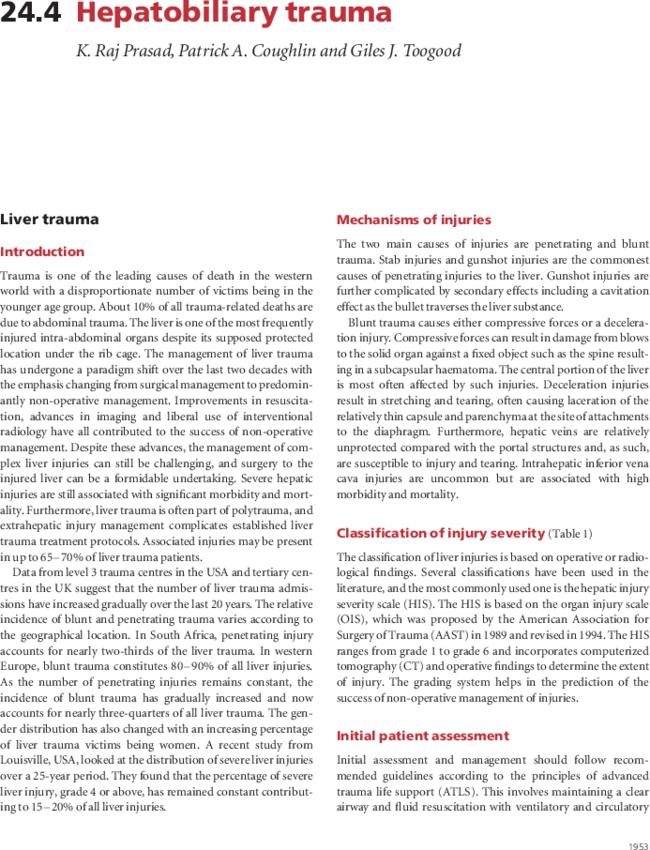Chapter 24.4
Hepatobiliary Trauma
K. Raj Prasad,
Patrick A. Coughlin,
Giles J. Toogood,
K. Raj Prasad
Search for more papers by this authorPatrick A. Coughlin
Search for more papers by this authorGiles J. Toogood
Search for more papers by this authorK. Raj Prasad,
Patrick A. Coughlin,
Giles J. Toogood,
K. Raj Prasad
Search for more papers by this authorPatrick A. Coughlin
Search for more papers by this authorGiles J. Toogood
Search for more papers by this authorBook Editor(s):Juan Rodés MD,
Jean-Pierre Benhamou MD,
Andres T. Blei MD,
Jürg Reichen MD,
Mario Rizzetto MD,
Juan Rodés MD
Director General, Hospital Clinic; Professor of Medicine, University of Barcelona, Barcelona, Spain
Search for more papers by this authorJean-Pierre Benhamou MD
Professor of Hepatology, Université Denis Diderot Paris 7, Assistance Publique — Hôpitaux de Paris and Inserm U773, Service d'Hépatologie, Hôpital Beaujon, Clichy, France
Search for more papers by this authorAndres T. Blei MD
Professor of Medicine and Surgery, Northwestern University, Feinberg School of Medicine, Chicago, IL, USA
Search for more papers by this authorJürg Reichen MD
Professor of Medicine, University of Bern; Chief of Hepatology, University Hospital, Bern, Switzerland
Search for more papers by this authorMario Rizzetto MD
Professor of Gastroenterology, University of Turin, Turin, Italy
Search for more papers by this authorFirst published: 18 June 2007

References
- Boerma D, Rauws EA, Keulemans, YC et al. (2001) Impaired quality of life 5 years after bile duct injury during laparoscopic cholecystectomy: a prospective analysis. Ann Surg 234 (6), 750–757.
- Chapman WC, Halevy A, Blumgart LH et al. (1995) Postcholecystectomy bile duct strictures. Management and outcome in 130 patients. Arch Surg 130 (6), 597–602; discussion 602–604.
- Christmas AB, Wilson AK, Manning B et al. (2005) Selective management of blunt hepatic injuries including nonoperative management is a safe and effective strategy. Surgery 138 (4), 606–610; discussion 610–611.
- Coughlin PA, Stringer MD, Lodge JP et al. (2004) Management of blunt liver trauma in a tertiary referral centre. Br J Surg 91 (3), 317–321.
- Croce MA, Fabian TC, Menke PG et al. (1995) Nonoperative management of blunt hepatic trauma is the treatment of choice for hemodynamically stable patients. Results of a prospective trial. Ann Surg 221 (6), 744–753.
- David Richardson J, Franklin GA, Lukan, JK et al. (2000) Evolution in the management of hepatic trauma: a 25-year perspective. Ann Surg 232 (3), 324–330.
- Debru E, Dawson A, Leibman S et al. (2005) Does routine intraoperative cholangiography prevent bile duct transection? Surg Endosc 19 (4), 589–593.
- Goldman R, Zilkoski M, Mullins R et al. (2003) Delayed celiotomy for the treatment of bile leak, compartment syndrome, and other hazards of nonoperative management of blunt liver injury. Am J Surg 185 (5), 492–497.
- Hollands MJ, Little JM (1991) Non-operative management of blunt liver injuries. Br J Surg 78 (8), 968–972.
- Johnson JW, Gracias VH, Gupta R et al. (2002) Hepatic angiography in patients undergoing damage control laparotomy. J Trauma 52 (6), 1102–1106.
- Kristensen JK, Buemann B, Kuhl E (1971) Ultrasonic scanning in the diagnosis of splenic haematomas. Acta Chir Scand 137 (7), 653–657.
- Lillemoe KD, Melton GB, Cameron JL et al. (2000) Postoperative bile duct strictures: management and outcome in the 1990s. Ann Surg 232 (3), 430–441.
- Malhotra AK, Fabian TC, Croce MA et al. (2000) Blunt hepatic injury: a paradigm shift from operative to nonoperative management in the 1990s. Ann Surg 231 (6), 804–813.
- Misra S, Melton GB, Geschwind JF et al. (2004) Percutaneous management of bile duct strictures and injuries associated with laparoscopic cholecystectomy: a decade of experience. J Am Coll Surg 198 (2), 218–226.
- Mohr AM, Lavery RF, Barone A et al. (2003) Angiographic embolization for liver injuries: low mortality, high morbidity. J Trauma 55 (6), 1077–1081; discussion 1081–1082.
- Moore EE, Cogbill TH, Jurkovich GJ et al. (1995) Organ injury scaling: spleen and liver (1994 revision). Trauma 38 (3), 323–324.
- Omoshoro-Jones, JA, Nicol AJ, Navsaria, PH et al. (2005) Selective non-operative management of liver gunshot injuries. Br J Surg 92 (7), 890–895.
- Parks RW, Chrysos E, Diamond T (1999) Management of liver trauma. Br J Surg 86 (9), 1121–1135.
- Pachter HL, Knudson MM, Esrig B et al. (1996) Status of nonoperative management of blunt hepatic injuries in 1995: a multicenter experience with 404 patients. J Trauma 40 (1), 31–38.
- Ragozzino A, De Ritis R, Mosca, A et al. (2004) Value of MR cholangiography in patients with iatrogenic bile duct injury after cholecystectomy. Am J Roentgenol 183 (6), 1567–1572.
- Scollay JM, Beard D, Smith R et al. (2005) Eleven years of liver trauma: the Scottish experience. World J Surg 29 (6), 744–749.
- Sicklick JK, Camp MS, Lillemoe KD et al. (2005) Surgical management of bile duct injuries sustained during laparoscopic cholecystectomy: perioperative results in 200 patients. Ann Surg 241 (5), 786–792; discussion 793–795.
- Strasberg SM (2005) Biliary injury in laparoscopic surgery: part 2. Changing the culture of cholecystectomy. J Am Coll Surg 201 (4), 604–611.
- Strasberg SM, Hertl M, Soper NJ (1995) An analysis of the problem of biliary injury during laparoscopic cholecystectomy. J Am Coll Surg 180 (1), 101–125.
- Thomson BN, Parks RW, Madhavan KK et al. (2005) Early specialist repair of biliary injury. Br J Surg 93 (2), 216–220.
- Tsalis K, Zacharakis E, Vasiliadis K et al. (2005) Bile duct injuries during laparoscopic cholecystectomy: management and outcome. Am Surg 71 (12), 1060–1065.



